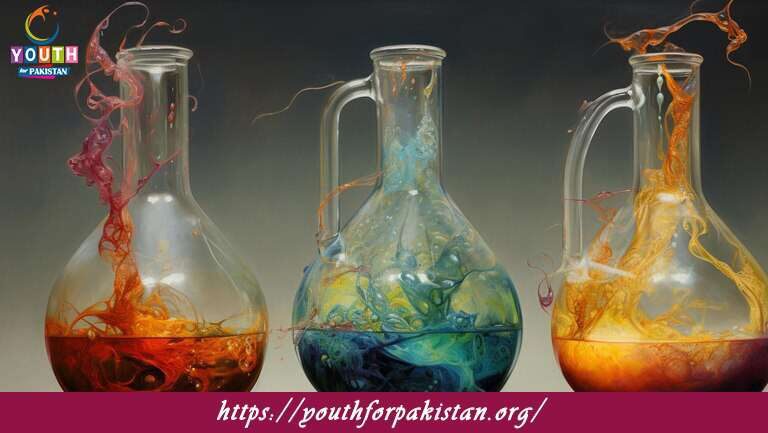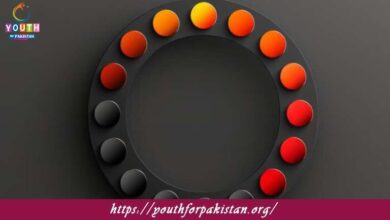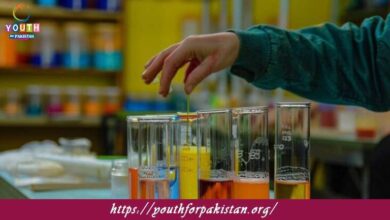11th Class Chemistry Chapter 8 MCQs with Answers

Master equilibrium concepts with Chemical Equilibrium MCQs, featuring Le Chatelier’s principle, equilibrium constants, and dynamic equilibrium. These Chapter 8 quizzes are designed to help 11th Class Chemistry students ace their exams.
In a chemical equilibrium, the rate of the forward reaction:
a) Decreases
b) Increases
c) Becomes zero
d) Remains constant
Which of the following does not affect the equilibrium constant (K) for a reaction?
a) Concentration of reactants
b) Temperature
c) Pressure
d) Addition of a catalyst
The equilibrium constant (K) for a reaction at a higher temperature is:
a) Higher
b) Lower
c) Unchanged
d) Zero
Le Chatelier’s principle predicts that if the temperature of an endothermic reaction is
increased, the equilibrium will shift:
a) Toward the products
b) Toward the reactants
c) No change in equilibrium
d) Equilibrium will be disrupted
A decrease in pressure will shift the equilibrium to the side with:
a) Fewer moles of gas
b) More moles of gas
c) No effect on equilibrium
d) Equilibrium will be disrupted
A catalyst increases the rate of the forward and reverse reactions but does not affect the position of the equilibrium. Why?
a) It increases the activation energy of the reaction
b) It decreases the activation energy of the reaction
c) It decreases the rate of the reverse reaction
d) It increases the rate of the forward reaction
The equilibrium constant (K) for a reaction is 1. If Q > 1, it means the reaction:
a) Is at equilibrium
b) Has more products than reactants
c) Has more reactants than products
d) Is not at equilibrium and proceeds in the forward direction
The equilibrium constant (K) for a reaction is 0.1. If Q < 0.1, it means the reaction:
a) Is at equilibrium
b) Has more products than reactants
c) Has more reactants than products
d) Is not at equilibrium and proceeds in the reverse direction
The equilibrium constant (K) for a reaction is 10. If Q = 10, it means the reaction:
a) Is at equilibrium
b) Has more products than reactants
c) Has more reactants than products
d) Is not at equilibrium and proceeds in the forward direction
What does it indicate if the value of the equilibrium constant (K) is very large for a reaction?
a) The reaction does not reach equilibrium
b) The reaction favors the products
c) The reaction favors the reactants
d) The reaction does not occur
If the value of the equilibrium constant (K) for a reaction is very small, it means:
a) The reaction does not reach equilibrium
b) The reaction favors the products
c) The reaction favors the reactants
d) The reaction does not occur
In a chemical equilibrium, the rate of the forward reaction is equal to:
a) The rate of the reverse reaction
b) The initial concentration of reactants
c) The concentration of products at equilibrium
d) The rate of reaction at the beginning
The state in a reversible chemical reaction where the forward and reverse reactions occur at the same rate is called:
a) Dynamic equilibrium
b) Static equilibrium
c) Thermodynamic equilibrium
d) Kinetic equilibrium
Which of the following does not affect the position of equilibrium in a chemical reaction?
a) Concentration of reactants and products
b) Pressure
c) Temperature
d) Presence of a catalyst
A reversible reaction is in equilibrium when:
a) The reactants are completely converted to products
b) The products are completely converted to reactants
c) The concentrations of reactants and products remain constant
d) The concentrations of reactants and products are equal
What is the effect of increasing the pressure on the equilibrium position of a gaseous reaction involving the same number of moles of reactants and products?
a) It shifts the equilibrium towards the side with more moles of gas
b) It has no effect on the equilibrium position
c) It shifts the equilibrium towards the side with fewer moles of gas
d) It disrupts the equilibrium
The equilibrium constant (K) for a reaction is 100. If the reaction quotient (Q) is 50, which statement is true?
a) The reaction is at equilibrium
b) The reaction will proceed in the forward direction to reach equilibrium
c) The reaction will proceed in the reverse direction to reach equilibrium
d) The reaction does not reach equilibrium
A reaction has an equilibrium constant (K) of 0.01. If the reaction quotient (Q) is 0.1, what does it indicate?
a) The reaction is at equilibrium
b) The reaction will proceed in the forward direction to reach equilibrium
c) The reaction will proceed in the reverse direction to reach equilibrium
d) The reaction does not reach equilibrium
The reaction quotient (Q) for a reaction at equilibrium is:
a) Always zero
b) Always equal to the equilibrium constant (K)
c) Always infinity
d) Not defined
What does it indicate if the reaction quotient (Q) is greater than the equilibrium constant
(K)?
a) The reaction is at equilibrium
b) The reaction favors the products
c) The reaction favors the reactants
d) The reaction does not reach equilibrium
The equilibrium constant (K) for a reaction is 10^6. What does it indicate about the reaction?
a) The reaction does not reach equilibrium
b) The reaction strongly favors the reactants
c) The reaction strongly favors the products
d) The reaction is not feasible
What is the relationship between the value of the equilibrium constant (K) and the extent of the reaction?
a) Larger the value of K, greater the extent of the reaction
b) Smaller the value of K, greater the extent of the reaction
c) Larger the value of K, lesser the extent of the reaction
d) Smaller the value of K, lesser the extent of the reaction
If the equilibrium constant (K) for a reaction is very large, it means:
a) The forward reaction is slow
b) The reverse reaction is slow
c) The reaction proceeds in both directions equally
d) The reaction proceeds predominantly in one direction
Which statement is true for an equilibrium constant (K) value close to 1?
a) The reaction is very slow
b) The reaction is very fast
c) The reactants and products are present in nearly equal amounts at equilibrium
d) The reaction does not reach equilibrium
The position of equilibrium in a reversible reaction is influenced by:
a) Temperature only
b) Concentration of reactants and products
c) Pressure and concentration of reactants and products
d) Presence of a catalyst only
If the rate of the forward reaction is equal to the rate of the reverse reaction in a chemical system, the system is said to be in:
a) Dynamic equilibrium
b) Static equilibrium
c) Thermodynamic equilibrium
d) Kinetic equilibrium
When a chemical system is at equilibrium, the concentrations of reactants and products:
a) Are equal
b) Are zero
c) Are changing continuously
d) Remain constant
Which of the following statements is true for a reaction at equilibrium?
a) The rate of the forward reaction is equal to the rate of the reverse reaction
b) The rate of the forward reaction is faster than the rate of the reverse reaction
c) The rate of the forward reaction is slower than the rate of the reverse reaction
d) The rate of the forward reaction is zero
For a reaction to be at equilibrium:
a) The rate of the forward reaction is greater than the rate of the reverse reaction
b) The rate of the reverse reaction is greater than the rate of the forward reaction
c) The rates of the forward and reverse reactions are equal
d) The rates of the forward and reverse reactions are zero
If a reversible reaction is initially at equilibrium and then the concentration of one of the reactants is increased, the reaction will shift:
a) Toward the products
b) Toward the reactants
c) No change in equilibrium
d) Equilibrium will be disrupted
If a reversible reaction is initially at equilibrium and then the pressure is increased, the reaction will shift:
a) Toward the products
b) Toward the reactants
c) No change in equilibrium
d) Equilibrium will be disrupted
In a chemical equilibrium, the rate of the forward reaction:
a) Decreases
b) Increases
c) Becomes zero
d) Remains constant
Which of the following does not affect the equilibrium constant (K) for a reaction?
a) Concentration of reactants
b) Temperature
c) Pressure
d) Addition of a catalyst
The equilibrium constant (K) for a reaction at a higher temperature is:
a) Higher
b) Lower
c) Unchanged
d) Zero
Le Chatelier’s principle predicts that if the temperature of an endothermic reaction is
increased, the equilibrium will shift:
a) Toward the products
b) Toward the reactants
c) No change in equilibrium
d) Equilibrium will be disrupted
A decrease in pressure will shift the equilibrium to the side with:
a) Fewer moles of gas
b) More moles of gas
c) No effect on equilibrium
d) Equilibrium will be disrupted
A catalyst increases the rate of the forward and reverse reactions but does not affect the position of the equilibrium. Why?
a) It increases the activation energy of the reaction
b) It decreases the activation energy of the reaction
c) It decreases the rate of the reverse reaction
d) It increases the rate of the forward reaction
The equilibrium constant (K) for a reaction is 1. If Q > 1, it means the reaction:
a) Is at equilibrium
b) Has more products than reactants
c) Has more reactants than products
d) Is not at equilibrium and proceeds in the forward direction
The equilibrium constant (K) for a reaction is 0.1. If Q < 0.1, it means the reaction:
a) Is at equilibrium
b) Has more products than reactants
c) Has more reactants than products
d) Is not at equilibrium and proceeds in the reverse direction
The equilibrium constant (K) for a reaction is 10. If Q = 10, it means the reaction:
a) Is at equilibrium
b) Has more products than reactants
c) Has more reactants than products
d) Is not at equilibrium and proceeds in the forward direction
What does it indicate if the value of the equilibrium constant (K) is very large for a reaction?
a) The reaction does not reach equilibrium
b) The reaction favors the products
c) The reaction favors the reactants
d) The reaction does not occur
If the value of the equilibrium constant (K) for a reaction is very small, it means:
a) The reaction does not reach equilibrium
b) The reaction favors the products
c) The reaction favors the reactants
d) The reaction does not occur
In a chemical equilibrium, the rate of the forward reaction is equal to:
a) The rate of the reverse reaction
b) The initial concentration of reactants
c) The concentration of products at equilibrium
d) The rate of reaction at the beginning
The state in a reversible chemical reaction where the forward and reverse reactions occur at the same rate is called:
a) Dynamic equilibrium
b) Static equilibrium
c) Thermodynamic equilibrium
d) Kinetic equilibrium
Which of the following does not affect the position of equilibrium in a chemical reaction?
a) Concentration of reactants and products
b) Pressure
c) Temperature
d) Presence of a catalyst
A reversible reaction is in equilibrium when:
a) The reactants are completely converted to products
b) The products are completely converted to reactants
c) The concentrations of reactants and products remain constant
d) The concentrations of reactants and products are equal
What is the effect of increasing the pressure on the equilibrium position of a gaseous reaction involving the same number of moles of reactants and products?
a) It shifts the equilibrium towards the side with more moles of gas
b) It has no effect on the equilibrium position
c) It shifts the equilibrium towards the side with fewer moles of gas
d) It disrupts the equilibrium
The equilibrium constant (K) for a reaction is 100. If the reaction quotient (Q) is 50, which statement is true?
a) The reaction is at equilibrium
b) The reaction will proceed in the forward direction to reach equilibrium
c) The reaction will proceed in the reverse direction to reach equilibrium
d) The reaction does not reach equilibrium
A reaction has an equilibrium constant (K) of 0.01. If the reaction quotient (Q) is 0.1, what does it indicate?
a) The reaction is at equilibrium
b) The reaction will proceed in the forward direction to reach equilibrium
c) The reaction will proceed in the reverse direction to reach equilibrium
d) The reaction does not reach equilibrium
The equilibrium constant (K) for a reaction is 10^6. What does it indicate about the reaction?
a) The reaction does not reach equilibrium
b) The reaction strongly favors the reactants
c) The reaction strongly favors the products
d) The reaction is not feasible
What is the relationship between the value of the equilibrium constant (K) and the extent of the reaction?
a) Larger the value of K, greater the extent of the reaction
b) Smaller the value of K, greater the extent of the reaction
c) Larger the value of K, lesser the extent of the reaction
d) Smaller the value of K, lesser the extent of the reaction
If the equilibrium constant (K) for a reaction is very large, it means:
a) The forward reaction is slow
b) The reverse reaction is slow
c) The reaction proceeds in both directions equally
d) The reaction proceeds predominantly in one direction
Which statement is true for an equilibrium constant (K) value close to 1?
a) The reaction is very slow
b) The reaction is very fast
c) The reactants and products are present in nearly equal amounts at equilibrium
d) The reaction does not reach equilibrium
The position of equilibrium in a reversible reaction is influenced by:
a) Temperature only
b) Concentration of reactants and products
c) Pressure and concentration of reactants and products
d) Presence of a catalyst only
If the rate of the forward reaction is equal to the rate of the reverse reaction in a chemical system, the system is said to be in:
a) Dynamic equilibrium
b) Static equilibrium
c) Thermodynamic equilibrium
d) Kinetic equilibrium
When a chemical system is at equilibrium, the concentrations of reactants and products:
a) Are equal
b) Are zero
c) Are changing continuously
d) Remain constant
Which of the following statements is true for a reaction at equilibrium?
a) The rate of the forward reaction is equal to the rate of the reverse reaction
b) The rate of the forward reaction is faster than the rate of the reverse reaction
c) The rate of the forward reaction is slower than the rate of the reverse reaction
d) The rate of the forward reaction is zero
For a reaction to be at equilibrium:
a) The rate of the forward reaction is greater than the rate of the reverse reaction
b) The rate of the reverse reaction is greater than the rate of the forward reaction
c) The rates of the forward and reverse reactions are equal
d) The rates of the forward and reverse reactions are zero
If a reversible reaction is initially at equilibrium and then the concentration of one of the reactants is increased, the reaction will shift:
a) Toward the products
b) Toward the reactants
c) No change in equilibrium
d) Equilibrium will be disrupted
If a reversible reaction is initially at equilibrium and then the pressure is increased, the reaction will shift:
a) Toward the products
b) Toward the reactants
c) No change in equilibrium
d) Equilibrium will be disrupted
If you are interested to enhance your knowledge regarding Physics, Chemistry, Biology, and Computer please click on the link of each category, you will be redirected to dedicated website for each category.




